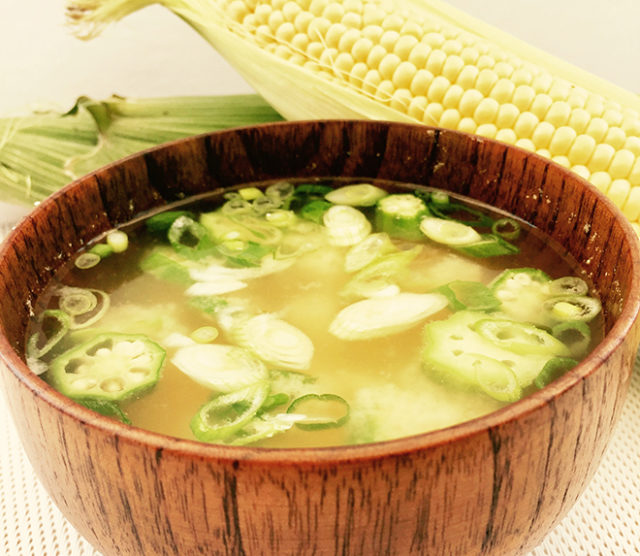I love to go to neighborhood farmers markets this time of year. Strolling through the market is like re-creating my summers growing up in Japan. Colorful produce stands arrayed with fresh vegetables such as corn, cucumber, okra, and eggplant immediately bring those memories back to life.
Like the Northwest, Japan has four distinctive seasons, and they are deeply rooted in everyday life — including food and cooking. In fact, there is a Japanese word, “shun.” It describes the time at which a food is in prime season and at the peak of its flavor. Many Japanese believe that every food should be eaten only when it is in shun.
As a Japanese chef who loves to partake in shun traditions, I am delighted to live in the Northwest, surrounded by an abundance of fresh seasonal produce and seafood. And one of my favorite ways to use fresh local ingredients is to enjoy them in miso soup. Miso soup is often served at Japanese restaurants as a complimentary starter before the main meal. But it is actually much more than just a side dish.
Miso is a superfood
Miso is a fermented food made with soybeans, salt, and Koji mold. It is rich in protein with essential amino acids, vitamins (particularly B2 and E), and minerals. It also provides probiotics for intestinal health, aids digestion, detoxifies the liver, and the list goes on. Combining fresh vegetables with this amazing food equals a powerful antioxidant. The English saying, “An apple a day keeps the doctor away,” has its Japanese counterpart, with miso soup taking the place of the apple!
Miso soup is easy and versatile
Cooking miso soup is very simple. First, decide on the type of miso. If you are not sure which one to buy, start with either pure red or white soybean miso to keep it simple. Red miso has a strong, rather spicy taste, whereas white miso is milder in flavor. You can also blend red and white miso if you like. Next, make a broth from kombu (dried kelp). For a richer flavor, you can combine kombu with bonito flakes (dried, fermented and smoked tuna).
Miso soup is highly versatile and can accompany rice or a hearty main dish. You can use any ingredients you want, from vegetables to seafood or even meat. Think of those seasonal flavor profiles and color combinations that go well together. Here are some examples of Northwest ingredients that are great for miso soup: SPRING asparagus, spring onion, green cabbage, potatoes, edible ferns such as fiddleheads, bamboo shoots SUMMER corn, okra, peas, zucchini, eggplant, tomatoes FALL mushrooms, turnip, satsuma yam (a very sweet Japanese sweet potato variety with a dense texture) kabocha pumpkin (It has a similar flavor profile to satsuma yam) WINTER daikon radish, napa cabbage, kabocha pumpkin ALL SEASONS onion, carrot, wakame (dried sea vegetable), tofu, spinach, burdock root, aburaage (fried bean curd)
Summer Miso Soup Recipe with Corn and Okra
I am in love with the incredibly sweet local corn in shun right now. I keep going back to the farmers markets in my neighborhood to buy more. Fresh local okra is also delicious. You can find it at Uwajimaya and some local Asian grocery stores. These two vegetables make a beautiful yellow and green contrast, and corn’s sweetness is a perfect marriage with the rich miso flavor.
Ingredients (serves 4-5 bowls)
- A 3 x 3-inch square kombu (dried kelp) – available at Asian grocery stores
- 3 1/3 cups water
- 1 ear fresh corn, shucked and kernels removed from cob (reserve cob for broth)
- 4 okra, sliced diagonally – if not available, blanched green beans or sugar peas can be used instead
- 2 – 3 tbsp. miso paste of your choice
- 2 tbsp. chopped green onion for garnish
Instructions
❶ Put a sheet of kombu, the corn cob, and water in a saucepan and bring to a boil over medium-high heat. Once mixture is boiling, remove the kombu. Cook another five minutes and remove the cob. Bonito flakes are not necessary in this recipe because the corncob makes a rich broth, but for extra flavor, you can add 1/4 cup of bonito flakes with the corncob and strain them out.
❷ Reduce heat to medium. Add the corn kernels and cook for about one minute more. Add okra and turn off the heat immediately. Add miso paste, stirring well until it is dissolved.
❸ Serve hot in individual bowls, garnished with green onion.
Recipe by Kanako Koizumi | www. kozmokitchen.com
Kanako, a native of Akita, Japan, is a chef, author and instructor focused on authentic Japanese homecooking. Chef Kanako also offers in-home private cooking classes for groups up to 12. You can reach her at info@kozmokitchen.com.
Editor’s Note: This article was origianly published on the “Balanced You (kcbalancedyou.com)” website in 2017.





